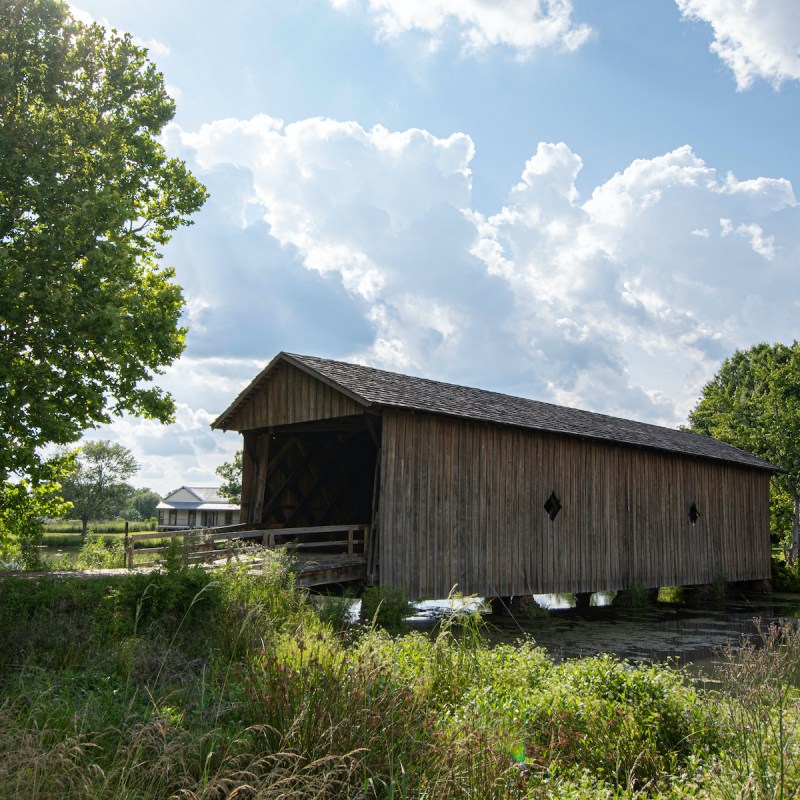
There is a special romance attached to covered wooden bridges. Crossing over the swift flowing waters of a creek or stream, these stout bridges that are held together by an intricate and almost artistic system of hand-hewn wooden trusses invoke images of days gone by when horse-drawn carriages would clip-clop across the thick wooden planking and lovers would sneak off to hide from the world and steal love’s first romantic kiss within their walls.
Videos by TravelAwaits
Alabama has its fair share of these beautiful structures, and thanks to the efforts of local historical preservation societies, many have been rescued, restored to their former glory, and moved to a location where you can walk through them.
Others are still in operation, and to this day, afford travelers a means of crossing the state’s rivers and gorges. Don’t worry. They have all been restored and strengthened to manage car traffic.
When you visit the state, take the time to get off the interstates and take the backroads to visit these six historic structures. While the best time to visit is in the fall when the leaves are ablaze with color, they are still fascinating and worth the visit no matter what time of year.

1. Swann Covered Bridge — Cleveland
Swann Covered Bridge is the first of three single-lane bridges that make up what is known as the Covered Bridge Trail in Blount County, a 13-mile route that uses U.S. Highway 231 as the backbone of the trip and three county roads. The trail was the idea of the Friends of the Covered Bridges of Blount County, who oversees the maintenance and care of the three bridges.
Swann has been used by travelers since 1933 to cross the fast moving current of the Locust Fork of the Black Warrior River. The river is a favorite of whitewater kayakers so you may have the added bonus of watching them navigate the rapids when you visit.
The bridge is 324 feet long, making it the longest surviving covered bridge in the state.
The single-lane bridge has a clearance of nine feet and is 10 feet wide. Limited parking is available on the north side of the river. A better parking option is on the south side with a wide area that accommodates more cars.
Each year, the bridge and its two counterparts are part of the Covered Bridge Arts and Crafts Festival (see Pro Tips below).

2. Easley Covered Bridge — Rosa
The second of the covered bridge triad in Blount County is Easley, a 95-foot-long single-lane bridge over the Calvert Prong of the Little Warrior River.
With its tin roof and town truss latticework sides, Easley is the oldest of the three covered bridges in Blount County, dating back to 1930.
The bridge has a clearance of nine feet and a width of 10 feet. If you want to park and view the bridge before driving across it, you can do so at the intersection of Easley Bridge Road and Pine Grove Road where there is a small pull off. From there, it is a short 100-foot walk to the bridge. Just watch for cars.

3. Horton Mill Covered Bridge — Oneonta
The final covered bridge of the Blount County trio is the Horton Mill Covered Bridge. Built in 1934, the Horton Mill Covered Bridge was named for local businessman Thurman Horton who built a mill complex consisting of a corn and flour mill, cotton gin, and sawmill only a mile upriver from the bridge on the Calvert Prong of the Little Warrior River.
The bridge, with its unique cantilevered lattice sides, stands 70 feet above the river making it the tallest covered bridge in the United States.
A bonus adventure when you visit Horton Mill is a short 2-mile (round trip) moderately difficult hike to the old mill site. It is rated moderate due to several steep climbs. The nature trail is part of the Alabama Birding Trail and is a nice walk through the hardwoods to views of the river and a chance to check off a few creek-side birds from your list like pileated woodpeckers, yellow-billed cuckoos, and a variety of warblers.
For driving across the bridge, Horton is 11 feet wide with a clearance of nine feet. Parking for the trail is located on Alabama Highway 75. The bridge itself is only 150 feet away where you can get some great photos.

4. Kymulga Grist Mill, Park, And Covered Bridge — Childersburg
With the exception of the Blount County triad of covered bridges just mentioned, many of the remaining bridges in Alabama have since been relocated from their original location. That’s not the case for the Kymulga Covered Bridge.
The bridge is part of the Kymulga Grist Mill, Park, and Covered Bridge site. This small park, which was purchased by the city of Childersburg and managed by the Childersburg Historic Preservation Commission, is listed in the National Register of Historic Places and features a water-powered grist mill, and this covered bridge that was built in 1864 along the banks of Talladega Creek. What makes the park extra special is that it is the only site in the state where the buildings and bridge still stand in their original location, having survived severe storms, flooding, and even the burning of other structures by the Union army during the Civil War.
The grist mill, museum, and historic Rainwater House that was built in 1894 make for a fascinating afternoon exploring the history of the mill site. Walking trails lead you around the grounds to the 105-foot-long covered bridge that spans the swift waters of the creek.
The park also offers canoe rentals so you can paddle Talladega Creek and RV and tent campsites. Visit the park’s website for current admission fees and operating hours.

5. Alamuchee-Bellamy Covered Bridge — Livingston
The Alamuchee-Bellamy Covered Bridge is one of the oldest remaining in the state but is another that has been relocated to preserve the structure.
The bridge was built in 1861 under the orders of William Alexander Campbell Jones, a Confederate army captain. The beautiful structure with its hand-hewn yellow pine timbers and hand-carved wooden pegs allowed horse and later auto traffic to cross the Sucarnoochee River until 1924 when it was replaced by a cement bridge.
The covered bridge was disassembled and moved to Alamuchee Creek where it saw service until it was replaced yet again by a cement bridge in 1958. With the help of the Sumter County Historical Society, the bridge was moved one last time to the University of West Alabama campus in Livingston, Alabama, where it was restored and can now be crossed via a walking path.
6. Coldwater Creek Covered Bridge — Oxford
Oxford Lake Park is a beautiful city park in the town of the same name that has been the site of community activities since 1884.
Anchored by a tranquil pond that offers anglers a chance to wet their line and try their hand at catching largemouth bass, grass carp, and catfish, the park features tennis courts, swimming pool, baseball fields, and basketball courts, and walking paths that take you across the 65-foot-long Coldwater Creek Covered Bridge.
The bridge was built by a former slave in 1850 (although some historians say it was actually built in 1839) over Coldwater Creek. Upon completion, the bridge quickly became known as the “kissing bridge,” as courting couples found it to be the perfect hideaway from the rest of the world to steal a kiss.
The bridge was used until 1920 when a cement bridge was constructed nearby. The Coldwater Bridge fell into disrepair by the time it was added to the National Register of Historic Places. In 1990, the community rallied around the bridge and moved it to its present location at Oxford Lake Park where it was restored and now provides walkers a historic route across the stream that flows from the lake. An added bonus is views of Cheaha, the state’s tallest mountain.
Pro Tips
When driving to and across Alabama’s covered bridges that are still in operation, use caution, be courteous, and be patient. Many of the roads leading to the bridges are winding making it difficult to see oncoming traffic.
The bridges are also single lane. Take turns alternating crossing the bridge with oncoming traffic. And be patient waiting for your turn to cross.
The best time to visit these bridges is in the fall when the leaves burst with color and the annual celebration of the bridges is held. It’s called the Covered Bridge Arts and Music Festival. The festival is held annually on the fourth weekend of October in the town of Oneonta in Blount County. The event celebrates the county’s three covered bridges — Swann, Easely, and Old Horton — with a day filled with arts and crafts, live entertainment, a pancake breakfast, quilt show, car show, and of course, self-guided tours of the three bridges.
An interesting event during the festival is a guided three-hour hike along the rocky banks of Locust Fork of the Black Warrior River from Swann Covered Bridge to the beautiful waterfall, Powell Falls.
Covered bridges have long been an allure for travelers throughout the U.S.:
